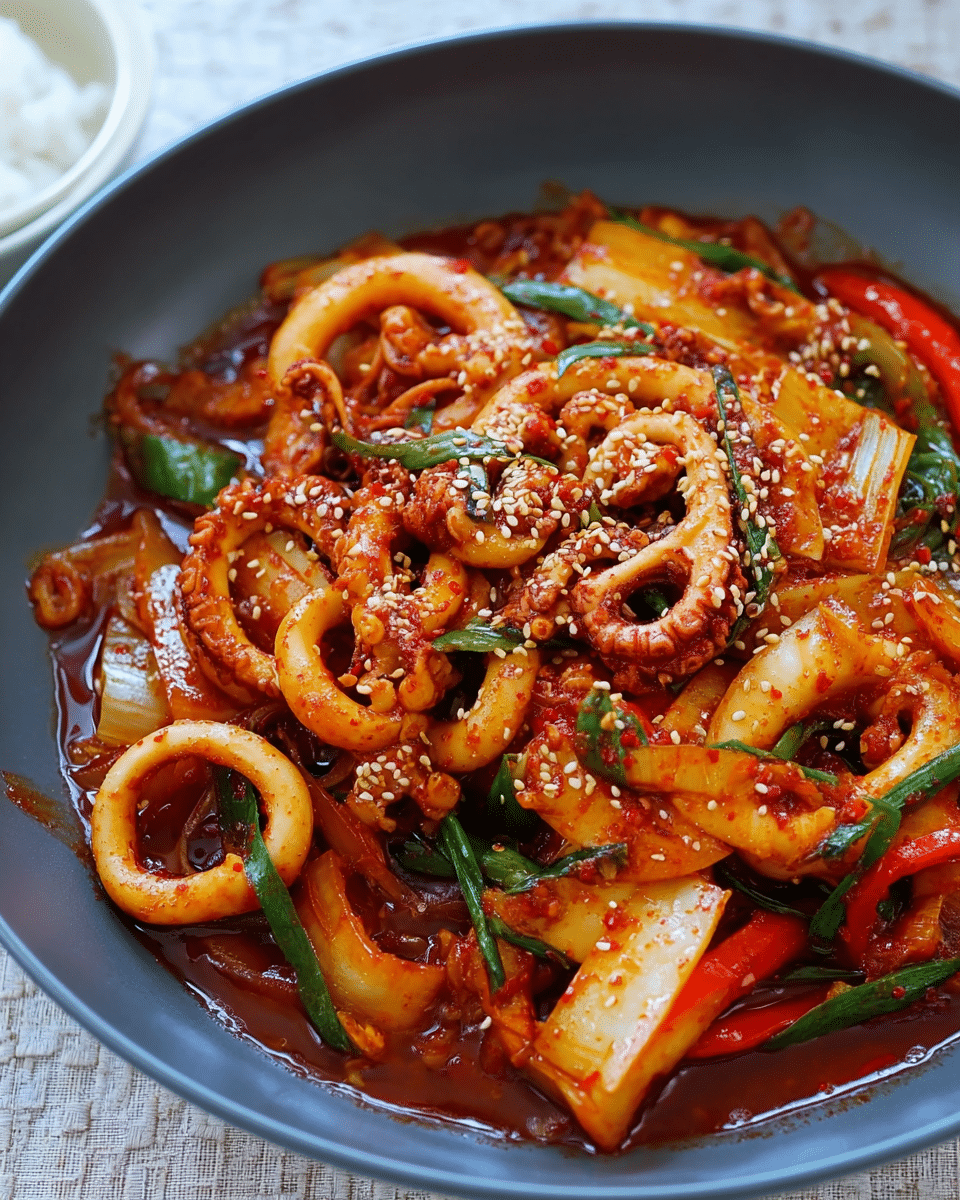Ojingeo Bokkeum is a flavorful and vibrant dish that brings the best of Korean cuisine to your table. With tender squid stir-fried in a spicy gochujang sauce, this dish is the perfect balance of heat and umami. The addition of fresh vegetables like bell peppers and onions enhances the dish’s texture and flavor, making it a satisfying and delicious meal.
Whether you’re a seafood lover or simply looking to try something new, this Korean Spicy Stir-Fried Squid is sure to impress. The combination of spicy, sweet, and savory flavors, along with the tender squid, creates a mouthwatering dish that’s both comforting and exciting.
Full recipe:
Ingredients:
-
1 lb (450g) squid, cleaned and cut into rings
-
1 tablespoon vegetable oil
-
1 onion, thinly sliced
-
1 bell pepper, sliced
-
2 cloves garlic, minced
-
1-inch ginger, minced
-
2 tablespoons gochujang (Korean chili paste)
-
1 tablespoon soy sauce
-
1 tablespoon rice vinegar
-
1 tablespoon honey
-
1 teaspoon sesame oil
-
1 tablespoon toasted sesame seeds
-
2 green onions, sliced
-
1 tablespoon gochugaru (Korean chili flakes) (optional, for extra spice)
Directions:
-
Heat the vegetable oil in a large pan or wok over medium-high heat. Add the onion and bell pepper, stir-frying for about 3-4 minutes, until softened.
-
Add the minced garlic and ginger, stir-frying for another minute until fragrant.
-
Add the squid to the pan and cook for about 2-3 minutes, just until the squid turns opaque.
-
In a small bowl, mix together the gochujang, soy sauce, rice vinegar, honey, and sesame oil. Pour the sauce mixture into the pan with the squid.
-
Stir to coat the squid and vegetables evenly, then cook for another 2 minutes until the sauce has thickened slightly.
-
Remove from heat and garnish with toasted sesame seeds and sliced green onions. If desired, sprinkle gochugaru for extra spice.
Prep Time: 10 minutes | Cooking Time: 10 minutes | Total Time: 20 minutes
Kcal: 220 kcal | Servings: 2 servings
The Rich History of Ojingeo Bokkeum
Ojingeo Bokkeum is a traditional Korean dish that has its roots deeply embedded in Korean culinary culture. Squid has long been a staple seafood in Korean cooking, particularly along the coastal regions where it is easily available. The preparation of seafood in Korean cuisine is diverse, with both fresh and dried varieties being utilized in various dishes. Ojingeo Bokkeum is one of the many ways squid is prepared, and it is typically enjoyed with a side of steamed rice, which helps balance the intense flavors of the dish. The dish is also a part of Korean home-cooked meals, often prepared for lunch or dinner as it is both quick and flavorful.
The key to the dish’s success is the combination of gochujang, a fermented chili paste that adds both spice and depth of flavor, and other ingredients such as soy sauce, sesame oil, garlic, and ginger. These ingredients work harmoniously to create a perfectly balanced sauce that coats the squid and vegetables, providing a savory and slightly sweet undertone.
Health Benefits of Ojingeo Bokkeum
Beyond its incredible flavor, Ojingeo Bokkeum also offers several health benefits. Squid is a great source of protein, low in fat, and rich in essential minerals like iron, zinc, and selenium. The high protein content of squid makes it an excellent choice for anyone looking to incorporate more lean protein into their diet. Additionally, squid contains omega-3 fatty acids, which are important for heart health and reducing inflammation in the body.
The vegetables added to the dish, such as onions and bell peppers, provide extra nutrients, including vitamins A and C, fiber, and antioxidants. The gochujang, while adding heat and spice, is also known for its health benefits, including aiding digestion and boosting metabolism. When prepared with these ingredients, Ojingeo Bokkeum becomes a wholesome, nutrient-rich dish that not only satisfies your taste buds but also supports overall health.
Perfect Pairings for Ojingeo Bokkeum
Ojingeo Bokkeum is often served with steamed white rice, which is the perfect companion to the spicy and savory squid. The rice absorbs the flavorful sauce from the dish, balancing out the heat and making it even more delicious. For an added dimension of flavor, some people enjoy pairing it with kimchi, a fermented vegetable side dish that complements the heat of the squid and adds a tangy crunch to the meal.
If you’re looking to elevate the meal further, consider serving it with a traditional Korean side of pickled vegetables, such as pickled radishes or cucumbers. These provide a refreshing contrast to the rich and spicy flavors of the stir-fried squid. Additionally, a cold glass of traditional Korean barley tea or a light, chilled drink like a Korean rice punch (sikhye) can also pair wonderfully with this dish, offering a refreshing balance to the spicy flavors.
Tips for Cooking Ojingeo Bokkeum
To achieve the best results when preparing Ojingeo Bokkeum, there are a few tips to keep in mind. First and foremost, it is important to properly clean and prepare the squid. If you’re using fresh squid, make sure to remove the innards, skin, and cartilage before slicing it into rings. For convenience, you can also purchase pre-cleaned and pre-sliced squid from your local market.
Cooking the squid for just the right amount of time is also crucial. Overcooking squid can make it rubbery and tough, so make sure to cook it only until it turns opaque, which usually takes about 2-3 minutes. The squid should remain tender and juicy, absorbing the flavors of the sauce without losing its delicate texture.
The sauce in Ojingeo Bokkeum is another key component of the dish. To make sure the sauce sticks to the squid and vegetables, stir-fry everything in high heat for a few minutes, allowing the flavors to meld together. The sauce should thicken slightly but not become too dry. If needed, you can add a splash of water or broth to adjust the consistency of the sauce.
Variations of Ojingeo Bokkeum
While the classic Ojingeo Bokkeum is made with squid, the recipe can be adapted to suit different preferences or dietary needs. For instance, some variations of this dish use other types of seafood, such as octopus or shrimp, instead of squid. These options offer slightly different textures but still pair wonderfully with the spicy and savory sauce.
For those who prefer a less spicy version, you can reduce the amount of gochujang or gochugaru (Korean chili flakes) used in the recipe. You can also experiment with adding other vegetables, such as mushrooms, carrots, or zucchini, to add more color and texture to the dish. The beauty of Ojingeo Bokkeum lies in its versatility, allowing for endless variations while still retaining its signature bold flavors.
Serving Ojingeo Bokkeum
Ojingeo Bokkeum is best served immediately after it’s cooked while the squid remains tender and the sauce is at its freshest. When plating the dish, garnish it with sliced green onions and a sprinkle of toasted sesame seeds for a touch of crunch and a burst of flavor. The bright green onions and sesame seeds add a pop of color and make the dish even more visually appealing.
To make the dish more substantial, you can serve it alongside a variety of Korean side dishes (banchan). These small dishes complement the main meal and offer a range of flavors, from pickled vegetables to sautéed greens, providing a well-rounded meal that feels authentic and satisfying.
Conclusion
Ojingeo Bokkeum is a quintessential Korean dish that combines heat, umami, and freshness in every bite. With its bold flavors and satisfying textures, it’s no wonder that this dish has become a favorite for many. Whether you’re new to Korean cuisine or a seasoned enthusiast, Ojingeo Bokkeum is sure to become a regular on your menu. Its simplicity, health benefits, and versatility make it a standout choice for any home cook looking to add some excitement to their meals.
So, gather your ingredients, fire up the stove, and treat yourself to a taste of Korea with this delicious and spicy stir-fried squid.






